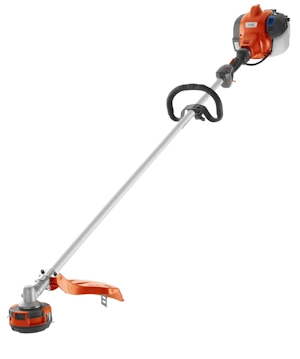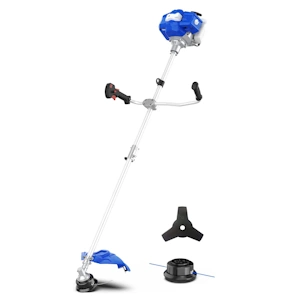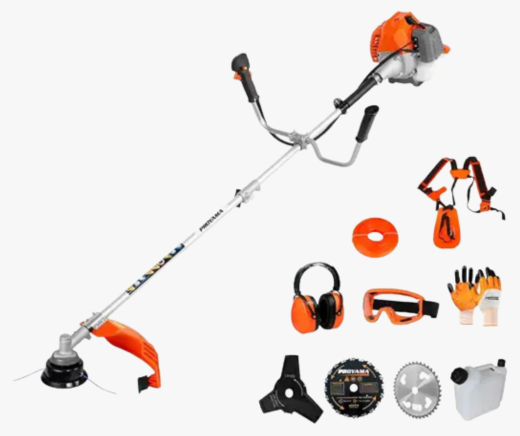If your STIHL weed eater won’t start, you’re not alone. Most of the time, it’s something simple—like old fuel, a dirty air filter, or a bad spark plug. I’ve had many mornings pulling the cord over and over with no luck.
Each time, it turned out to be an easy fix. After lots of trial and error, I’ve learned what works. Let’s go through it together and get your trimmer running again—no guesswork needed.
Table of Contents
First Things First – Are You Starting It Right?
Why the Starting Order Matters

It might seem simple, but many STIHL weed eaters won’t start just because of the wrong starting steps. These tools need fuel, air, and spark in the right order. That’s what the controls are for.
Here’s a quick checklist:
- Choke: Use it on a cold engine. It helps start the fuel mix.
- Primer bulb: Press it 5–6 times to push fresh fuel into the carb.
- Throttle trigger: Some models need this held down to start.
Common mistakes include using the choke when the engine is warm, not using it when cold, or pumping the primer too much. Even pros mess this up when rushing.
Warm vs. Cold Starts
If you’re starting it first thing in the morning, that’s a cold start. If it’s mid-job after a break, that’s a warm start—and the steps change.
- Cold start: Use the choke and prime 5–6 times.
- Warm start: Skip the choke. Prime 1–2 times, hold the throttle, then pull.
Fuel Troubles – The #1 Problem

Is Your Fuel Fresh and Mixed Right?
Old or bad fuel is the top reason STIHL weed eaters won’t start.
All 2-stroke STIHL trimmers need a 50:1 mix. That’s 2.6 oz of oil for each gallon of gas. Don’t guess—measure it. I use a gas can with markings so I don’t mess it up.
Why it matters: Old gas breaks down. I once used fuel from last fall—big mistake. The trimmer sputtered and quit. Fresh fuel fixed it right away.
If your mix is over a month old—or sat in a hot shed—replace it. Most gas has ethanol, which pulls in water and can separate. Use a fuel stabilizer or try STIHL MotoMix® for storage.
Flooded Engine? How to Tell and Fix It

Flooding happens when there’s too much fuel and not enough air. The spark plug gets soaked.
How to tell if it’s flooded:
- Strong gas smell
- Wet spark plug
- Cord feels hard to pull
Two ways to fix it:
Method 1: No tools
- Turn the choke OFF
- Squeeze the throttle all the way
- Pull the cord 10–15 times
It may spit smoke or cough—but it’ll fire.
Method 2: With tools
- Remove the spark plug
- Wipe it dry with a rag
- Pull the cord 4–5 times with no plug
- Reinstall the plug and pull to start (no choke)
Check the Airflow – Can Your Engine Breathe?
If your STIHL weed eater won’t start, it might not be getting enough air. Just like we need clean air to breathe, your engine does too. A dirty filter or blocked muffler can stop the air it needs to run.
Cleaning or Replacing the Air Filter
Signs your air filter is clogged:
- It starts but dies right away
- It bogs down when you press the throttle
- It smells rich or smokes a lot
The air filter blocks dirt from entering the engine. But when it’s full of grass or dust, it chokes off the air. That throws off the fuel mix and stops your engine from running right.
What I do: I check my filter every 10 hours of use—or more often if I’m trimming dusty areas. It’s usually behind a plastic cover near the pull cord. I use a soft brush to clean it. If it’s still dirty or feels oily, I replace it. Filters are cheap. Engines aren’t.
Don’t Forget the Spark Arrestor
A lot of people miss this. The spark arrestor is a tiny screen in the muffler. It stops sparks from flying out. But over time, it can get blocked by carbon—especially if you use cheap oil or let the trimmer idle too much.
Signs it’s clogged:
- Engine starts but dies when you rev it
- It idles rough
- Exhaust smells weird
My 5-minute fix:
- Find the muffler (it’s usually on the side)
- Remove the screw holding the screen
- Burn off buildup with a propane torch, or soak in carb cleaner
- Scrub it clean with a wire brush
- Reinstall once it cools
Don’t toss the screen. It’s there for safety. Removing it is illegal in most U.S. states.
Spark Check – Is the Ignition Working?
If you’ve got fuel and air, but it still won’t start, check the spark. No spark means no fire.

Check the Spark Plug
Your spark plug can tell you a lot. It’s like a window into the engine.
Here’s what to look for:
| Plug Color | What It Means |
| Light tan/gray | Perfect—good mix and clean burn |
| Dry black soot | Too much fuel—running rich |
| Wet and black | Flooded—too much gas |
| White and crusty | Too little fuel—running lean and hot |
How to Test for Spark (Without a Tool)
No tester? No problem. Try this:
- Take out the spark plug
- Leave it connected to the wire
- Press the metal part to the engine
- Pull the cord and look for a blue spark
If you see a spark, your plug and coil are working. No spark? Check the plug wire. I once found a corroded wire inside the boot causing the issue.
Still no spark after that? Your ignition coil may be bad. That’s a bigger fix—but at least you’ve ruled out the basics.
Fuel System Deep Dive – If the Basics Didn’t Work
If you’ve checked for spark, cleaned the air filter, and used fresh fuel—but your STIHL trimmer still won’t start—it’s time to go deeper. These steps take a little more work, but most people can do them with a few tools and a bit of care.
In-Tank Fuel Filter Problems
Inside the tank is a small fuel filter. If it’s clogged, fuel won’t reach the engine—even if the primer bulb still works.
How to find it:
- Pour out the old fuel into a safe container.
- Use a clean wire hook or long tweezers (I use a bent coat hanger).
- Slowly pull the fuel line out of the tank opening. Be gentle so you don’t tear it.
- At the end of the line, you’ll see a small round filter.
Should you clean or replace it?
I change mine once a year. It’s cheap and easy. If you want to clean it, rinse it in clean fuel and tap out any dirt. But for a few bucks, I usually just swap it. You can find STIHL filters at hardware stores or online.
Cracked Fuel Lines and Vacuum Lock
Even with a clean filter, fuel may not flow if there’s a crack in the line—or a blocked vent in the cap.
Signs to look for:
- Primer bulb won’t fill—or it stays flat.
- Engine starts but stalls fast.
- You hear a light hiss when opening the fuel cap (built-up pressure).
Quick trick: The fuel cap test
Try this: loosen the fuel cap a little, then pull the cord. If the engine runs better, the tank vent may be blocked. Many STIHL trimmers have vents built into the cap. In that case, replacing the cap might fix it.
Advanced Fixes – When It’s More Than Just Maintenance
If you’ve checked everything and your STIHL trimmer still won’t start, don’t worry—you’ve already ruled out the common stuff. Now it’s time to go deeper. We’re talking about the carburetor, compression, and on some models, the valves. These fixes aren’t part of everyday care, but they’re often the next step.

Carburetor Problems: Clean or Replace?
The carburetor mixes fuel and air before it reaches the engine. If it fails, your engine may flood, stall, or not start at all—especially after sitting for months.
Signs your carb might be bad:
- Engine starts but stalls, even with fresh gas
- It only runs with the choke partway on
- Primer bulb feels soft or doesn’t refill
- You smell fuel, but nothing fires up
Clean or replace?
Try cleaning first if you’re comfortable removing it. Use spray carb cleaner in all holes and ports. But if the diaphragm is hard or cracked, it won’t work—no matter how clean it looks.
Why I often replace it: A new carb costs around $15 to $40. That’s usually cheaper and faster than a rebuild kit. Most STIHL models have easy-to-find parts in U.S. stores or online.
Compression & Valve Problems (for 4-MIX® Engines)
Some STIHL trimmers like the FS 91 R, FS 111, and FS 131 use 4-MIX® engines. These are special engines that mix 2-stroke fuel but also have valves—just like a car.
Why this matters:
If the engine loses compression, it won’t start. The valves might be out of adjustment, which stops it from firing even if fuel and spark are fine.
Signs of a compression or valve issue:
- The pull cord feels too easy—no pressure
- It coughs once but never starts
- It ran last season but now feels “dead”
When to stop and ask a pro:
Adjusting valves is possible with a feeler gauge, but it’s easy to mess up. If you’ve tried everything else, it might be time to visit a STIHL-certified tech. Most shops offer this as part of a seasonal tune-up.
How to Prevent This Problem in the Future
After too many mornings pulling the starter rope with no luck, I stopped thinking these problems were random. Most of the time, they can be avoided. Now, I follow a simple routine—and my STIHL trimmer starts in one or two pulls, even after sitting all winter.
The Fuel I Now Use (and Recommend)
The biggest change I made was with fuel.
I used to mix regular pump gas with 2-stroke oil. That worked for a while. But most U.S. gas has ethanol. After a few weeks in storage, my trimmer would act up. The carb gummed up. The primer bulb felt soft and weird.
Now, I only use ethanol-free fuel for anything I don’t use right away. I buy STIHL MotoMix® (it’s pricey but clean) or I make my own mix using 93-octane ethanol-free gas. I get it from a nearby farm supply store. If you live in a rural area, check co-ops or visit Pure-Gas.org to find a station.
It takes a little more effort—but it saves time, money, and stress.
My Seasonal Checklist (It’s Quick)
Before each season—spring, summer, and fall—I do a simple 15-minute check:
Spring:
- Dump last year’s fuel
- Add fresh 50:1 mix
- Clean or replace the air filter
- Check the spark plug and gap it
- Prime it, choke it, and let it warm up
Mid-Season:
- Check fuel lines and primer bulb
- Clean the spark arrestor
- Blow out the air filter
Fall/Winter:
- Run the tank dry or add stabilizer and run for 5 minutes
- Remove spark plug and add a drop of oil into the cylinder
- Store the trimmer in a dry place, off the floor
How I Store My STIHL Trimmer (And Why It Changed Everything)
Storing it right makes a big difference. I used to hang it up after the last mow and forget it. Then in spring, it wouldn’t start.
Now I do two things:
- Run it dry or treat the fuel:
If I plan to use it again soon, I add stabilizer and let it idle for 5 minutes. That pulls the treated gas into the carb. - Fog the cylinder:
I add one drop of 2-stroke oil into the spark plug hole. Then I pull the cord slowly a few times. This coats the inside walls and stops rust.
I also store it off the ground. Garages and sheds get damp in winter. Concrete pulls in moisture. A wall hook or shelf keeps the trimmer safe and dry—ready for spring.
Read More: Echo Edger vs Stihl Edger
Conclusion: Most STIHL Starting Problems Are Easy to Fix
If your STIHL weed eater won’t start, don’t panic. Most of the time, it’s a small issue—old gas, a dirty filter, or too much fuel. I’ve had all of these problems. After years of yard work, I’ve learned that they’re usually easy to fix once you know what to check.
Quick recap:
- Always follow the right starting steps—use the choke and primer the right way
- Use fresh, well-mixed fuel (ethanol-free is best if storing)
- Clean your air filter and spark arrestor often
- Check for spark with a simple visual test
- If it still won’t start, check the fuel lines, in-tank filter, and carb
- For 4-MIX® engines, a valve check or compression test might be needed
FAQs: STIHL Weed Eater Not Starting
Why is my STIHL weed eater not starting after sitting all winter?
Old fuel is the most common cause. Gas breaks down and gums up the carburetor. Drain it, add fresh 50:1 mix, and try again.
What should I check first if my STIHL weed eater won’t start?
Start with the basics: fresh fuel, correct choke use, clean air filter, and a good spark plug. Most issues come from one of these.
How do I know if my STIHL trimmer is flooded?
A strong gas smell, wet spark plug, and tough pull cord are signs. Let it sit or clear it by pulling with full throttle and no choke.
Can bad fuel cause a STIHL weed eater not to start?
Yes. Ethanol in gas can cause buildup and water separation. Use fresh, ethanol-free fuel or MotoMix for best results.
Do STIHL weed eaters need different starting steps when warm?
Yes. Warm engines usually don’t need choke. Just prime once or twice, hold the throttle, and pull the cord to restart.




